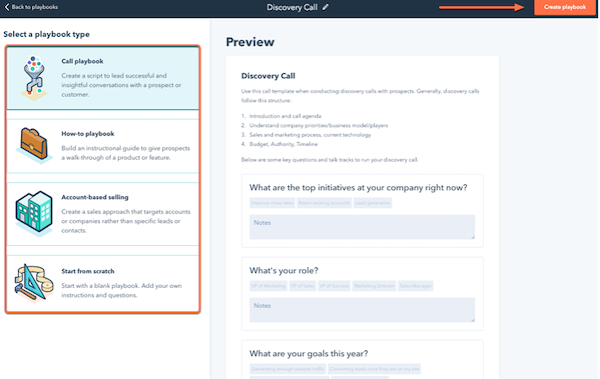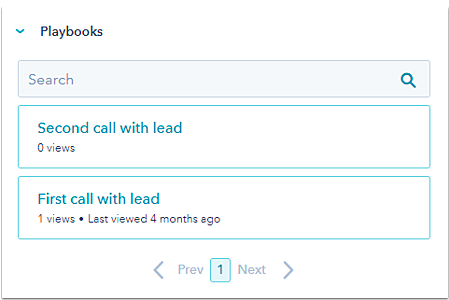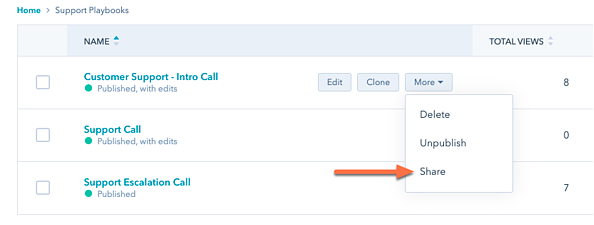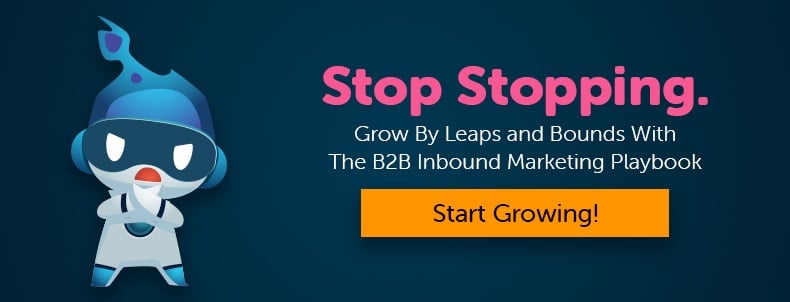You started your business because you’re good at what you do. You know you can serve a purpose, and serve it well. You know the industry, what your audience needs, and maybe you even have a niche. But even if you are the crėme de la crème, sales can still be tricky — especially in a B2B setting.
Thankfully, HubSpot playbooks can simplify this process and make it easier to navigate for your sales team and build a sales enablement strategy. This is because the tool enables you to pretty much give them a cheat sheet for any stage of the buyer’s journey. This way, they can navigate conversations with prospects with much more confidence. But, what exactly are these playbooks? In which contexts can you use them to serve you best? And how do you set them up?
What are HubSpot Playbooks?
HubSpot Playbooks is sales management software that enables you to create guides, scripts, and battle cards for sales representatives. Essentially, it's sales enablement on steroids. You can tailor this content into whatever format serves you best. For example, you can create:
- Product and services features and specifications
- Questions to ask during a discovery call
- Pricing guidelines charts
- Differences between your company and your competitors
- Negotiating tactics
- Customer support information
- Responses to common objections
You can then store all of this information right within your HubSpot account, and keep all customer related questions and answers within their contact file or deal record.
Benefits of HubSpot Playbooks
There are many advantages to using HubSpot playbooks. Implementing these tools will help you run your business more efficiently by setting the stage for:
1. Better Training
Onboarding new hires is time consuming. One of the best ways to streamline this process is by providing your new employees with the resources they need to do their job as effectively as possible. What are common questions prospects raise? What are their apprehensions? How can they put together an accurate proposal, or quickly identify upsell opportunities? Having a knowledge base at their fingertips that they can access at any time will take away a lot of the stress that comes with learning curves.
2. Standard Procedures
If you have a handful of managers, chances are that they all have different ways of doing things. Maybe they all reach the same end goal, but it becomes a mess when trying to explain the process to someone else. HubSpot Playbooks can help you ensure that you have standard operating procedures (SOPs). This consistency is crucial for sustainability and future trainings.
3. Time Efficiency
If your sales reps don’t have all of the answers they need when they need them, they can waste time — and likely lose sales opportunities — if they have to pause a sales conversation or tell a prospect they’ll get back to them. Plus, answering everything thoroughly builds trust and shows your prospects that your sales team knows what they’re talking about.
7 Ways to Use Sales Playbooks to Close More Deals
HubSpot Playbooks can be implemented through many stages of the sales process, including:
Qualifying Leads
Playbooks can be specifically dedicated to lead qualification. Include all the information on how sales reps can identify highly qualified leads to get in contact with.
Product Demonstrations
Your product demonstrations may have a standard process for your sales reps to follow. Make sure they don’t miss any steps or any key features by including all the information they need to demo specific products and features to their prospects.
Personalized Content
Use the playbooks to direct your reps on how they can select and share personalized content that fits the buyer’s journey and the prospect’s interactions. This helps to nurture leads and provides them with useful information as they consider their options and your offerings.
Use Cases
Your sales reps may not be able to recall relevant use cases at a moment’s notice. Create a playbook for use cases and detailed case studies that members of your target audience can relate to. This also provides them with very specific details that may not have otherwise been on their radar.
Prospecting
Playbooks ensure that your sales reps have all the information they need to identify ideal prospects across a variety of platforms and channels. Using a playbook for prospecting allows you to gain prospects that will convert into qualified leads and then into customers.
Closing
Playbooks can provide your sales team with closing tactics that allow them to engage with leads in the last phase of the buyer’s journey with ease. And because they have each prospect's relevant information, they'll know which points to highlight in their efforts to get them to sign on that dotted line.
Follow Up
Follow-up processes are essential to the sales process. Make sure your reps know when to follow up with prospects at different points throughout the buyer’s journey using a sales playbook; and whether the prospects prefer to be reached via phone call or follow up email.
How to Set Up HubSpot Playbooks
Alright. Ready to get this party started? Follow these step-by-step instructions to create the playbooks that best align with your specific goals. Remember that you can create several of them and categorize them (e.g. Product features, common apprehensions, customer support, etc...).
Creating Playbooks
1. Navigate to the Sales tab in your HubSpot account.
Then, click Playbooks.
2. Click Create Playbook in the upper right.

Source: HubSpot
3. Select a playbook type on the left panel.
The types you can choose from are the how-to playbook, account-based selling playbook template, or call script. You may also choose to create a playbook from scratch.
4. Enter the title for your playbook by clicking the pencil icon.
5. Click create playbook.
6. Write the body content.
You can use the toolbar to format your content, add images, insert links, and embed codes.

7. Your users have access to a set of questions and predetermined answers with the Questions & Answers icon. To add this, click the icon and write a question or prompt.
To select an answer option: Open text field only, use a set of answers that saves as a note, or use a set of answers that saves to a property.
8. Click Save.
9. Click the Settings tab after you write your playbook content.
10. Log the engagement type by clicking the Engagement type dropdown box.
Select Email, Call, Meeting, or another engagement type.
11. To see what the playbook will look like, navigate to the upper right corner and click preview.
12. When you are finished, click Publish.
Managing Playbooks
1. After you log in to HubSpot, click Sales and then Playbooks.
2. Use the search bar to find a specific playbook name.

3. Filter playbooks by creator by clicking the View dropdown box.
4. To edit, delete, clone, or unpublish a playbook, use your mouse to hover over the playbook name.
Select the edit or clone button on the dropdown. Click the More option to select Unpublish or Delete.
5. To share the playbooks with other users, click the More dropdown menu, and select Share.
6. You can organize your playbooks into different folders to make it easier for users to find the playbooks they need.
To do this, click New Folder in the upper right corner. Then, enter a name for your folder, and select Add Folder.
Select the check box next to a playbook and then hit Move to place all the selected playbooks into a folder.

Using Playbooks
1. Find your companies, deals, contacts, or tickets in your HubSpot account.
2. Click the name of the record you want.
3. On the right side menu in the Playbooks section, use the search bar to find a playbook or click one to open it.
The playbook content will show up in a pop-up window. If your playbook has a Question & Answer Icon, select quick replies and enter text before saving it to a contact property or notes.
4. Click Log (engagement type) after you are finished using the playbook.
The engagement type should be the same as the one you used on the settings tab in the editor.

5. If the engagement type is a call or a meeting, Select a call or meeting outcome.
The playbook will save as an engagement on the object timeline with the questions, answers, and any notes. Any properties that are linked to a question and answer will be updated with the responses you selected or entered while using the playbook.
Sales Playbook Examples (+ Template)
Here are three sales playbook examples that you should create and add to your playbook library on HubSpot.
Brand Introduction Playbook
A brand introduction sales playbook is great for new sales reps. It effectively introduces your brand's story to your sales team.
In this playbook, you can include your company mission at the top followed by your company vision, company core values, business strategy, and sales strategy.
This template allows companies to condense their mission so they only include the most important information that strictly focuses on how the sales team fits into the overall mission and how they will help solve for the company.
Sales Meeting Playbook
Sales meetings need to be structured and organized so sales reps can gain more wins. Sales meeting playbooks help sales reps to understand their prospect's pain points, situation, and desire to use the product.
They also allow them to demonstrate unique product value for each lead and agree on a plan to move forward.
You'll need to include the following items to make a successful sales meeting template:
- Goals of the meeting
- Research conducted prior to the meeting
- The agenda
- Example narrative
- Discovery phase: qualifying questions
- Demonstration
- Closing statements
Your sales reps will be able to refer to this template to keep the meeting on track.
Product Position and Messaging Playbook
Product positioning and messaging is important for sales reps to know for each product offering you have. They don't need to be overwhelmed with a bunch of information on your products, and the best way to organize this information is through a playbook.
Some of the elements to include in this playbook include:
- Value proposition
- Positioning statement
- Elevator pitch
- Brand pillars
- Key benefits
- Supporting product features
Sales playbooks are the perfect tool for sales teams to use in order to increase their close rate. And remember to treat your sales playbooks as a living document. They must evolve with your business. As you scale, you'll want to include additional relevant information.
Get a Free HubSpot Audit
Coming up with the most effective B2B strategies takes a lot of planning and strategizing. Let us help you. Get a free HubSpot audit, and we’ll not only help you identify the tools you can best use to align with your goals, but we’ll also give you actionable steps so that you can move forward with confidence.




Alejandra Zilak
Alejandra Zilak is a content writer, ghostwriter, blogger, and editor. She has a bachelor's degree in journalism and a Juris Doctor. She's licensed to practice law in four jurisdictions and worked as an attorney for almost a decade before switching careers to write full time. She loves being part of the Bluleadz team and implementing SEO best practices with her content. When not working, she loves to read, write fiction, and long distance running.